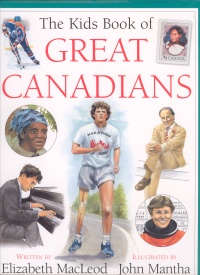| ________________
CM . . .
. Volume XII Number 10 . . . .January 20, 2006
excerpt:
A potpourri of mini-biographies of more than 150 famous Canadians, this book serves as an introduction to the men and women who made (and continue to make) Canada great. Not all of the people featured in the book were born here, but their contributions to this country warrant their inclusion. The people represent all walks of life; some are well-known only in Canada, but others are known around the world. From Celine Dion to Wayne Gretzky, each person’s brief bio covers between one-third of a page and a whole page and includes a small box in which are printed the person’s date of birth, date of death, if applicable, and their claim to fame. The biographies are grouped by categories- heroes (e.g. Terry Fox), exploration, science and technology, business (think Timothy Eaton), the arts, government, and sports. An entire page is devoted to Canada’s Nobel Prize winners, and it is followed by several pages covering a variety of other “greats,” with no more than a few sentences explaining their contributions. Some of these people deserve more extensive coverage and should have been included in the main chapters. David Suzuki, for instance, should have merited a place in the Science and Technology section, but his bio is a mere three sentences long. Occasionally, “Did You Know” fact boxes provide additional information. Illustrations consist of mixed media paintings and some reproductions of commemorative postage stamps. A table of contents, an index and a time line are included. Recommended. Gail Hamilton is a teacher-librarian in Winnipeg, MB.
To comment
on this title or this review, send mail to cm@umanitoba.ca.
Copyright © the Manitoba Library Association. Reproduction for personal
use is permitted only if this copyright notice is maintained. Any
other reproduction is prohibited without permission.
NEXT REVIEW |
TABLE OF CONTENTS FOR THIS ISSUE
- January 20, 2006.
AUTHORS |
TITLES |
MEDIA REVIEWS |
PROFILES |
BACK ISSUES |
SEARCH |
CMARCHIVE |
HOME |
